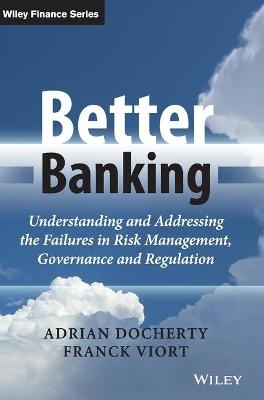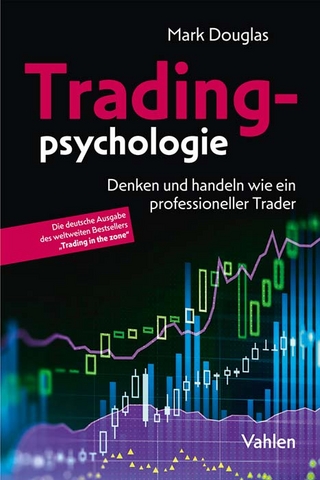
Better Banking
John Wiley & Sons Inc (Verlag)
978-1-118-65130-8 (ISBN)
Why did the financial crisis happen? Why did no one see it coming? And how did our banks lose so much of our money? What's being done to sort out the banking industry? And will it work?
These are the questions that industry experts Adrian Docherty and Franck Viort cover in Better Banking: Understanding and Addressing the Failures in Risk Management, Governance and Regulation. They give a clear and thorough run-through of some of the key concepts and developments in banking, to enable the reader to understand better this vital yet perilous industry. Without excessive detail or jargon, they explain the most important issues in risk management, regulation and governance and build a comprehensive description of how failings in these areas resulted in the current financial crisis. In order to make the diagnosis clear, the authors illustrate their descriptions with a series of informative case studies. The book revolves around a critique of the current regulatory developments, which the authors feel will be ineffective in fixing the structural flaws in banking. Crucially, and as the title of the book suggests, they set out their own series of proposals to contribute to the development of a better, safer and more effective banking industry.
Docherty and Viort's book fills an important gap in the literature on banking and its role in the current financial crisis. It is at once a history, a primer, a critique and a manifesto. It does not take sides but works through a constructive diagnosis towards ideas that could lead to major improvements in the quality and stability of the financial world.
Better Banking: Understanding and Addressing the Failures in Risk Management, Governance and Regulation is a technical yet accessible book that seeks to engage interested readers of all kinds -- students, professionals, bankers and regulators but also politicians and the broader audience of citizens outside the banking industry, who are keen to inform themselves and understand what needs to be done to avoid a repeat of this crisis.
Adrian Docherty and Franck Viort have, in aggregate, 40 years of experience serving and advising the financial services sector on strategic issues, in a variety of economic conditions and in many different countries around the world. Their professional focus is on helping to improve the financial management and risk performance of banks and insurance companies. Better Banking is their first book, though their views are regularly quoted in the press and they are frequent presenters at industry conferences. Adrian holds a master’s degree from Cambridge University and lives with his wife, son and daughter in Kent. Franck has a degree from Sciences-Po in Paris and an MBA from the University of Chicago and lives in London with his wife and three daughters.
Acknowledgements xi 1 Introduction 1
1.1 Overview and Objectives 1
1.2 Quick Start Guide to Banking Concepts and Regulation 4
2 The Global Financial Crisis 7
2.1 From Deregulation to dotcom Crash 7
2.2 The Seeds of a Crisis 9
2.3 “Why Didn’t Anyone See This Coming?” 14
2.4 The Beginnings of a Crisis 17
2.5 The Crisis Intensifies 20
2.6 Meltdown: The Lehman Bankruptcy 21
2.7 Massive Intervention Internationally 23
2.8 Sovereign Crises 29
2.9 Aftershocks and Skeletons in the Cupboard 32
2.10 Who is to Blame? 34
3 Methodologies and Foundations 37
3.1 How do Banks Make or Lose Money? 37
3.2 What’s a Bank Worth? Key Issues in Accounting for Banks 41
3.3 What is Risk? 47
3.4 What is an RWA? 55
3.5 What is Capital? 61
3.6 What are Liquidity and Funding? 68
3.7 What is a Derivative? 84
3.8 Mark-to-Market and Procyclicality 90
3.9 Role of Regulation, Supervision and Support 96
3.10 Ratings Agencies and Credit Ratings 101
3.11 Analysts, Investors and Financial Communication 109
4 Regulation of the Banking Industry 113
4.1 The Relevance of Bank Regulation and Supervision 113
4.2 Regulation and Supervision of the Banking Industry Prior to “Basel I” 113
4.3 The Basel Capital Accord aka “Basel I” 117
4.4 Basel II 122
4.5 Basel III 141
4.6 Resolution Regimes 163
4.7 Other Current Regulatory Workstreams 171
5 Case Studies 175
5.1 RBS 176
5.2 Dexia 179
5.3 HBOS 184
5.4 HSBC 189
5.5 Bear Stearns 192
5.6 Merrill Lynch 196
5.7 AIG 200
5.8 JP Morgan 207
5.9 Barclays 213
5.10 UBS 217
5.11 Northern Rock 221
5.12 Bankia-BFA 223
5.13 Australia 228
5.14 Canada 233
5.15 Summary of “Lessons Learned” from the Case Studies 236
6 Objectives and Design Principles 239
6.1 Free Market versus State Capitalism 240
6.2 Are There Alternatives to Banks? 242
6.3 Benefi ts and Limitations of Finance 250
6.4 How Much Risk Can We Tolerate? 251
6.5 The Role of Regulation and Supervision 254
6.6 The Role of “the Market” 256
6.7 Conclusions: Proposed Objectives and Design Criteria 258
7 A Blueprint for “Basel IV” 259
7.1 Risk Management 261
7.2 The Guardian Angel 269
7.3 Human Capital 275
7.4 Governance 287
7.5 Capital 291
7.6 Liquidity and Funding 299
7.7 The “Pillar 2” Mindset 303
7.8 Glasnost: Market Discipline and “Pillar 3” 311
7.9 Industry Structure 313
8 Challenges 327
8.1 Industry Entrenchment 327
8.2 Human Behaviour 329
8.3 Performance Management for Good Risk Management 332
8.4 Timing 333
8.5 A Positive Challenge: Technological and Social Progress 333
9 What Next? A Call to Arms 335
Glossary & Jargon Lookup 339
Disclaimer Regarding Excerpts from S&P Materials 349
Index 351
| Erscheint lt. Verlag | 7.2.2014 |
|---|---|
| Reihe/Serie | Wiley Finance Series |
| Verlagsort | New York |
| Sprache | englisch |
| Maße | 178 x 250 mm |
| Gewicht | 816 g |
| Themenwelt | Wirtschaft ► Betriebswirtschaft / Management ► Finanzierung |
| Betriebswirtschaft / Management ► Spezielle Betriebswirtschaftslehre ► Bankbetriebslehre | |
| ISBN-10 | 1-118-65130-8 / 1118651308 |
| ISBN-13 | 978-1-118-65130-8 / 9781118651308 |
| Zustand | Neuware |
| Haben Sie eine Frage zum Produkt? |
aus dem Bereich



